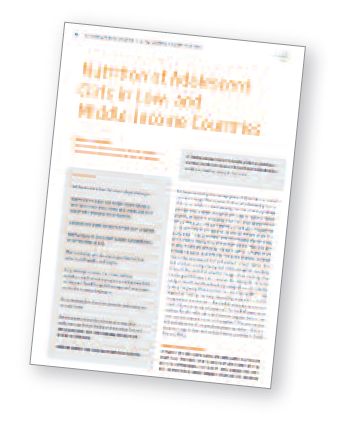Nutrition of adolescent girls in lowand middle-income countries
 David I. Thurnham, Sight and Life, Volume 27 (3) 2013.
David I. Thurnham, Sight and Life, Volume 27 (3) 2013.
Available at www.sightandlife.org
Adolescence during the teenage years of 13 to 19 is a time of dramatic change. Adolescence is the only time in life besides the critical window of the first 1000 days when the velocity of growth actually increases. For many girls, the opportunity to benefit from this period of potential growth is curtailed by early pregnancy. This article describes the nutritional status and requirements of adolescent women in low- and middleincome countries and highlights some of the problems posed by malnutrition and early marriage.
Key messages
- Many children in low- and middle-income countries enter adolescence thin, stunted and anaemic, and often have other micronutrient deficiencies.
- Adolescence is an opportunity for catch-up growth.
- Many adolescent girls become pregnant before they achieve adult weights and heights.
- Early marriage increases the risks of maternal mortality, complications in pregnancy and impaired fetal development (small-for-gestational age) and may prevent any further maternal height gain.
- Early marriage, low education, poor diet and poverty are strongly linked.
- Promoting secondary education for girls may delay early marriage. School feeding with nutritious food attracts adolescent girls into secondary education and helps keep them there.
- Efforts to promote food fortification with micronutrients, in combination with dietary diversity, will help combat malnutrition, may benefit adolescent growth and build a healthier workforce to reduce poverty in the future.
While adolescence is an opportunity for catch-up growth, poor diets and the physical demands of early marriage and pregnancy curtail the opportunities for growth. To address this, education needs to be promoted to increase the age of marriage, micronutrient fortification should be supported to improve dietary quality, and a high quality and diverse diet should be promoted to ensure adequate bone growth.

